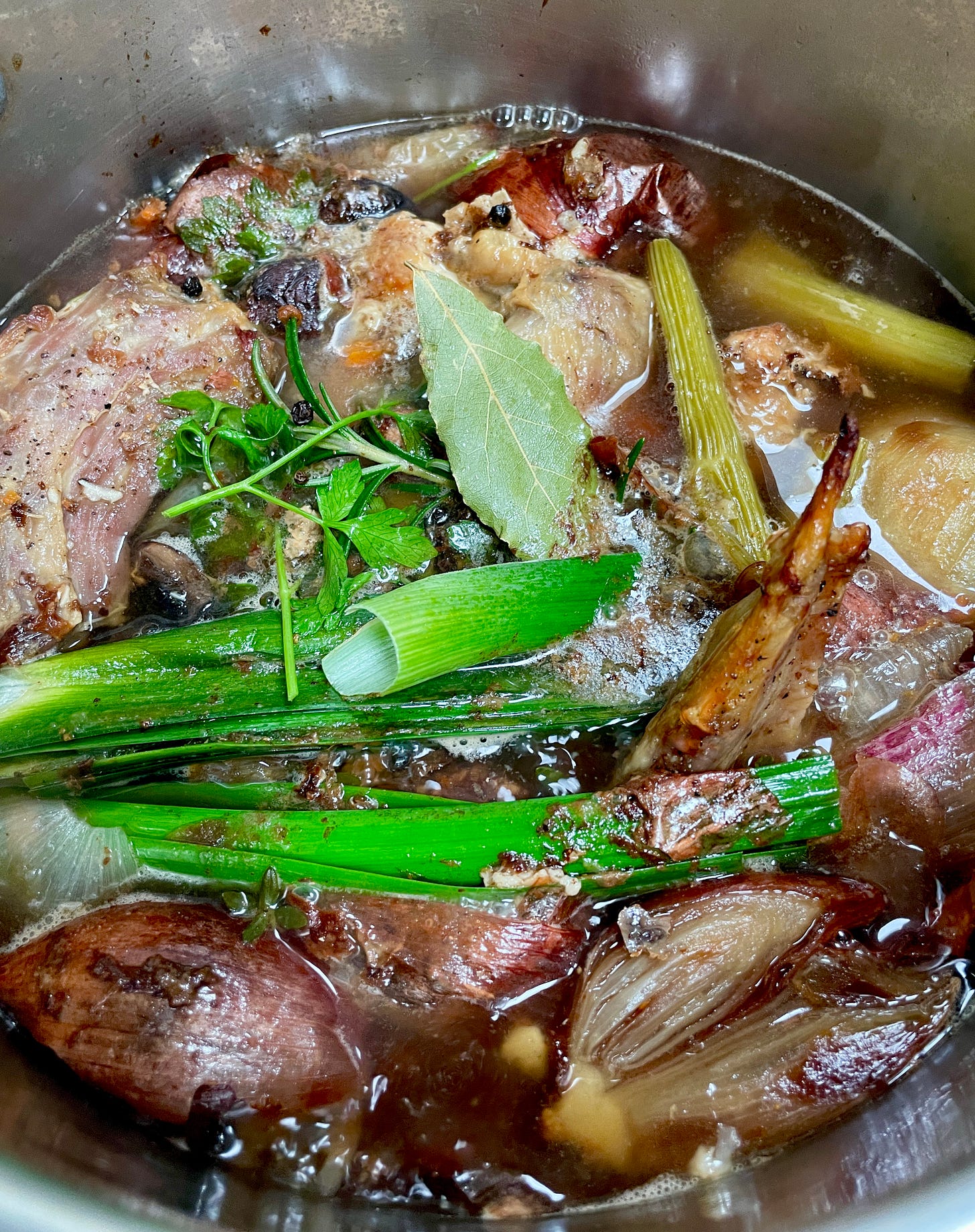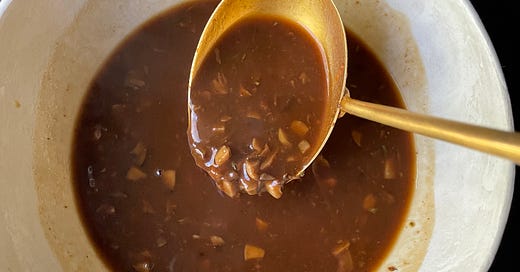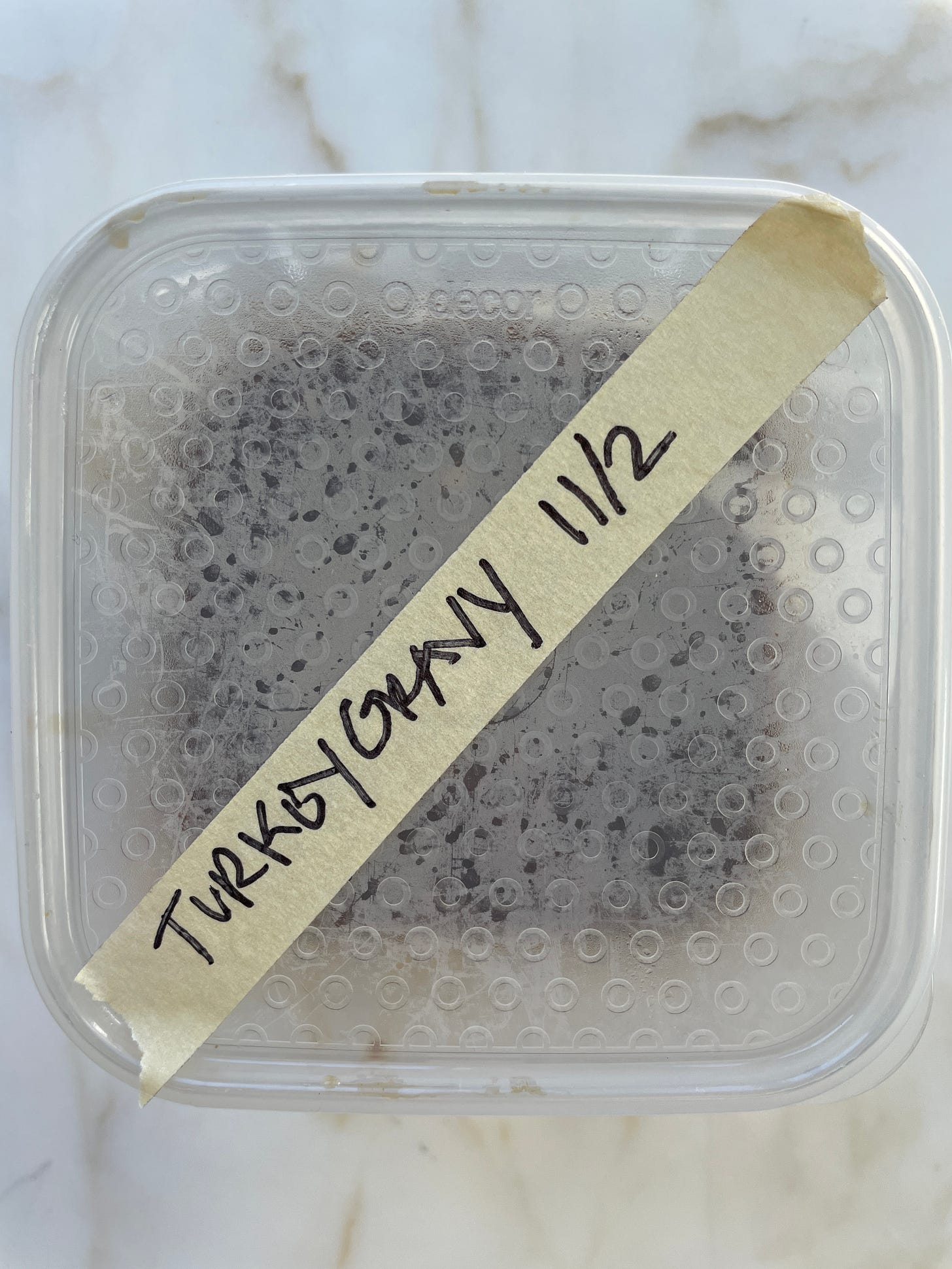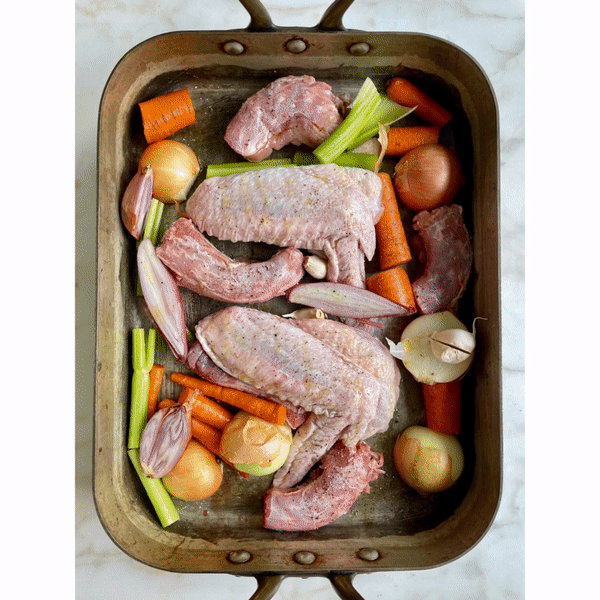Hi and welcome to Susanality, a newsletter by me, Susan Spungen, that celebrates seasonal cooking. If you enjoy today’s recipes, please help spread the word by forwarding this email to others who may like it too!
This month and next, I will be sharing a LOT of holiday content. If you are a free subscriber, now is a good time to consider upgrading in order to have access to it all — including a paid -only Thanksgiving hotline on 11/23, during which you will be able to ask and get immediate answers to any cooking (or baking) queries as you prep for the big meal. And, of course, December will be full of cookies. If you want all of it to land in your inbox, consider investing in a paid subscription (for less than the cost of a latte per month!). Either way, thank you so much for being here — I appreciate you all.
I think we can all agree that gravy is a very, very important part of Thanksgiving dinner. So why then do we sometimes wait until the very last minute to make it while also trying to multitask the rest of the meal — in a kitchen filled with a million people and distractions, no less?
Everyone wants a magic formula for making perfect gravy right before the meal is served, but I’m not sure it can be done. To get the proper “fond” (French word for all the tasty brown bits that stick to the pan), the conditions have to be just right. And it doesn’t always happen.
To eliminate the stress and ensure that my gravy is delicious (and ample!), I prefer to make my gravy (lots of it) well before the big day. I promise you that this gravy, which is built on a very flavorful stock, will beat a last-minute pan gravy any day, and all you have to do during crunch time is heat it up.
That said, if you do get some nice pan juices or fond on your roasting pan while cooking your turkey, don’t waste it! By all means, add it to the pre-made gravy to make it even more flavorful. You can deglaze the pan with white wine or water and stir it right in.
The first step in this gravy recipe is to make my brown turkey stock (recipe below), which is easy and cheap. This time of year, most supermarkets have turkey parts in the meat case, or you can ask the butcher for them. I easily found a pack of 5 small turkey necks ($1.86!) and a package of 2 big wings ($7.70). Go ahead and get your big roasting pan out (because you’re going to need it soon anyway) to make the stock. The necks, wings (backs are good too or even drumsticks), and stock vegetables will go into the oven until they’re nice and caramelized, which takes 1 ½ to 2 hours.
After you’ve made the stock and strained it, it’s time to reduce it by half to concentrate the flavors. At this point, you can save the stock for another day, or go right into making the gravy all the way through. In this gravy, mushrooms add flavor as well as texture — somewhat evocative of giblet gravy, but honestly much better (sorry giblet lovers!). Dried porcini and madeira (or sherry) add even deeper flavor.
I have the most delicious head start (in my freezer) on my holiday cooking, and I could not be happier about it! I’ll have more ideas and strategies in the next few weeks about how to get ahead!
What is Beurre manié?
Though it’s not written into the recipe below, I do recommend having some beurre manié — gravy’s secret weapon — on hand to help thicken your gravy while it simmers.
You’ve probably made or at least heard of roux before, but what about beurre manié? Beurre manié (kneaded butter) is sometimes called “lazy roux” because it’s added to sauces at the end of cooking, rather than at the beginning. Some will tell you that roux is better because the raw flour taste gets cooked out, but trust me, the difference is imperceptible — and it allows you have complete control over the thickness of your gravy as it cooks. If your gravy is bubbling away on the stove and still looks a little thin, you can just add a lump of beurre manié, whisk it in, and watch it thicken instantly.
Beurre manié is made with room temperature butter and an equal amount of flour thoroughly mixed in. Kneading it by hand (rather than trying to mix it with a spoon) is the best way to go, because the warmth of your hand makes it easy to combine smoothly.
When making beurre manié to be used while cooking this gravy recipe, combine 2 tablespoons butter and 2 tablespoons flour. You may not use it all, but it will ensure you have enough to work with.
A great turkey source
Finally, a PSA before we get to the recipes: Now is the time to place your turkey orders! In case you want to try something different this year (Turketta? Confited Turkey Legs?), or if you just want to order a delicious responsibly raised fresh turkey, The Butcher Girls, Erika Nakamura and Jocelyn Guest, have got you. I’m going to be cooking a spatchcocked turkey (turkey #2!) from Butcher Girls outside on my Traeger Grill.

Brown Turkey Stock
Makes 9 to 10 cups (before reducing)
You can use any combination of turkey parts for this stock, but wings, backs, and necks are best for the collagen (read: body) that they add to the stock. In addition to onions, you could add leek greens, shallots, and/or scallion tops to the mix as well, either before you roast the vegetables or when you simmer them. You could also add mushroom stems or a few mushrooms too. Start this in the morning on a day when you’ll be around the house — it takes hours, but it’s mostly hands off. You will need to have 4 cups of reserved stock to use for your gravy.
2 pounds turkey wings (2 large)
1 pound turkey necks (4 to 5 small or 1 large)
2 stalks celery, cut into large chunks
4 small carrots, cut into large chunks
3 small yellow onions, halved
4 garlic cloves, unpeeled
Kosher salt
1 cup white wine
Parsley stems
Sprigs of thyme
1 sprig of rosemary
Handful of peppercorns
1 bay leaf
Heat oven to 400℉. Arrange turkey parts, celery, carrots, onions, garlic, and any optional vegetable scraps (see intro copy for ideas) in a large roasting pan. Sprinkle lightly with salt and pepper. Cook for 1 ½ to 2 hours, turning the turkey parts once, until everything is nice and brown.
Transfer the contents of the roasting pan to a stockpot using tongs and/or a spatula. Put the roasting pan over a burner on your stove and add the wine. Use a wooden spoon to scrape up all the brown bits in the pan and transfer to the pot. Add 2 cups of water to the pan to rinse it and add that to the pot.
Add another 12 cups of water to the pot, stir, and bring to a boil over high heat. Add the parsley stems, thyme, rosemary, peppercorns, and bay leaf. Turn heat down to a simmer and cook for 2 hours. Let cool slightly and strain through a fine mesh strainer into a large bowl or a clean saucepan.
At this point, if you’d like, you can set aside some stock (about 2 cups) that you may want for other cooking projects like stuffing or side dishes. Pour the remainder of the stock into a large saucepan (or keep it in the pot it’s already in), and reduce by about half over high heat for 1 to 2 hours, or until you have about 4 cups. Let cool and chill or freeze until needed. Scrape off the fat on top before using.
Rich Mushroom Gravy
Makes about 3 cups
1/2 ounce (about 3/4 cup) dried porcini mushrooms
1 cup boiling water
1 (8-ounce) package cremini (baby bella) mushrooms, washed and trimmed
2 tablespoons unsalted butter
1 teaspoon chopped fresh rosemary
Salt and freshly ground pepper
3 tablespoons all-purpose flour
1/2 cup dry madeira or dry sherry
4 cups reduced turkey stock
Put the dried porcini mushrooms in a small or medium sized bowl. Pour 1 cup boiling water over them, stir to make sure all mushrooms are moistened, and let sit to soften and cool, about 15 minutes. When cool, scoop the mushrooms out of the liquid, chop them finely, and reserve the liquid.
Chop the fresh cremini mushrooms into 1/4-inch pieces. Melt the butter in a medium saucepan over medium heat. Add the fresh mushrooms, 1/2 teaspoon salt, pepper to taste, the softened chopped porcini, and rosemary, and cook for 6 to 8 minutes, until the mushrooms exude a lot of liquid and then start to dry out again.
Sprinkle the flour over the mushrooms, and cook, stirring for 1 minute. Add the madeira and scrape up the bits from the bottom of the pan, cooking 1 minute longer.
Add the stock and reserved porcini liquid (pour off the liquid leaving any grit behind) and bring to a boil. Lower heat and simmer until slightly thickened. If the gravy needs thickening, use some beurre manié (see a how-to for this above the recipes!). Adjust seasonings. Let cool, then chill in the fridge overnight before freezing until needed.








brilliant!! Love this gravy deep dive--for me, gravy IS thanksgiving!
I cooked the gravy over two days, making the stock, cooling and moving it to the fridge. The only step I wondered about was skimming the fat. Removing from the fridge the next morning I expected to see a nice clean layer of fat that I could easily remove. There seemed to be a little fat on the surface and I skimmed that off but I couldn't really tell if I needed to be more aggressive. Too aggressive and I would remove too much of the gravy. I think I removed about two tablespoons of fat directly of the surface and called it good.